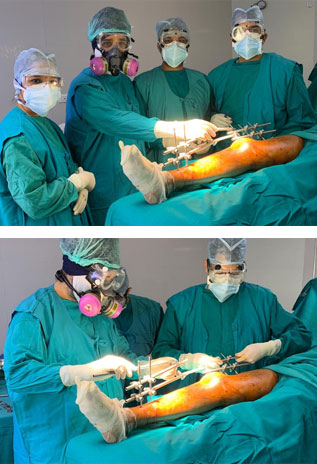It’s no secret that good knees are an essential part of a healthy and active lifestyle.
However, when injury or arthritis occurs, particularly osteoarthritis, your ability to bend and flex your knees can become restricted due to damage, inflammation and pain. Over time, the damage progresses and life becomes more difficult…and painful.
Deterioration of your joint and surrounding tissue can make it difficult to perform basic daily activities, even while you sit or lie down. As cartilage wears and bone rubs against bone, pain and reduced mobility follow.
Knee replacement surgery is a common solution that provides dramatic pain relief for more than 90 percent of patients. The vast majority of knee replacement procedures are used to treat osteoarthritis. The procedure—introduced in 1968—relies on a mechanical implant to replace severely arthritic or damaged knee joints. According to the Agency for Healthcare Research and Quality, more than 600,000 knee replacements took place in the U.S. last year, and that number is expected to grow into the millions within the next twenty years. Total knee replacement (TKR), also called total knee arthroplasty (TKA), is considered one of the safest and most effective procedures in orthopedics.
Two different types of knee replacement exist: total and partial.
Total Knee Replacement
Total Knee Replacement makes up about 90 percent of all knee replacement procedures. During TKR, a surgeon repairs your knee joint by covering the thighbone with a metal covering and encasing the shinbone with plastic. The prosthesis replaces the rough and irregular surfaces of the worn bone with smooth surfaces. In many cases, the surgeon also replaces the undersurface of your kneecap with a plastic surface, in order to further reduce pain and provide a smoother functioning joint. The procedure involves some removal of bone and cartilage.
After a TKR, you should expect to spend three to five days at the hospital. You will begin weight-bearing therapy immediately following the operation. In addition, you will undergo some combination of physical and occupational therapy starting at the hospital. In most cases, you will likely be able to stand and walk, at least with the assistance of a cane or walker, before you leave the hospital. Starting in the hospital, and usually before you exit the operating room, your knee may be cradled in a passive motion machine and medical staff will monitor the flexion (bending in) and extension (extending out) limits of your knee. After discharge, you will likely go home for recovery and rehabilitation. Some patients require home health care or assistance. Your doctor will most likely prescribe physical therapy at a local clinic for continued rehabilitation, and the physical therapist there will then suggest exercises you can do at home. Most patients conclude rehabilitation within eight weeks—at which point you should be able to move around without assistance and resume of your daily activities.
Partial Knee Replacement
If you receive a partial knee replacement, your surgeon will replace only the part of your knee that’s damaged or arthritic. The advantage to this approach is that it requires a smaller incision, involves less bone and blood loss and consequently, produces less pain. Patients undergoing partial knee replacement tend to experience a faster recovery time than those who have TKR. However, there are disadvantages, including the possibility that you will have to eventually undergo further surgery if arthritis develops in the parts of the knee that are not replaced.
Risks, Complications, and Considerations
Today, knee replacements are safe. Very few patients experience complications. The most common surgical complication is infection, which has been documented to occur in fewer than 2 percent of patients.When complications do occur, they may include: infection, blood clots, a problem with the implant, or persistent pain and damage to the blood vessels surrounding the knee as a result of the surgery. Thoroughly discuss the benefits and risks of TKR with your surgeon before making any decision about a procedure. You may also want to evaluate other considerations, such as: financial issues (the cost of surgery, follow-up care, and time off from work), hospital quality, and what to expect from your new knee.
TKR is an increasingly attractive and viable option if you’re dealing with chronic knee pain or unable to participate in common activities. Approximately 90 percent of the replacement joints last 10 years, and about 80 percent function for 20 years. There’s a high probability that you will once again participate in activities such as walking, bicycling, golf, tennis and swimming. As the pain subsides and the ability to use your knee returns, your quality of life will most likely improve.



